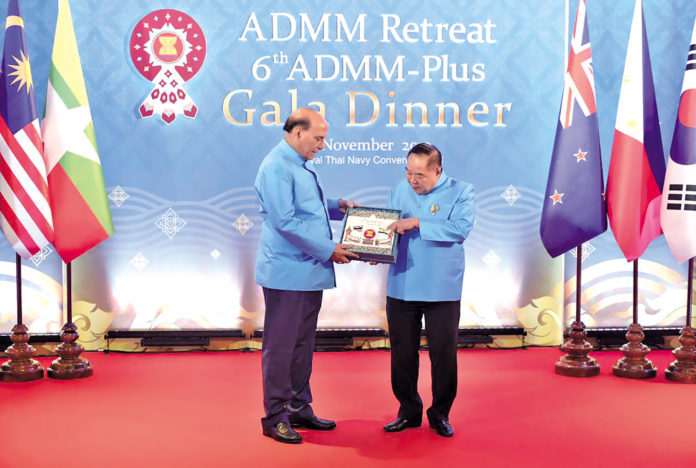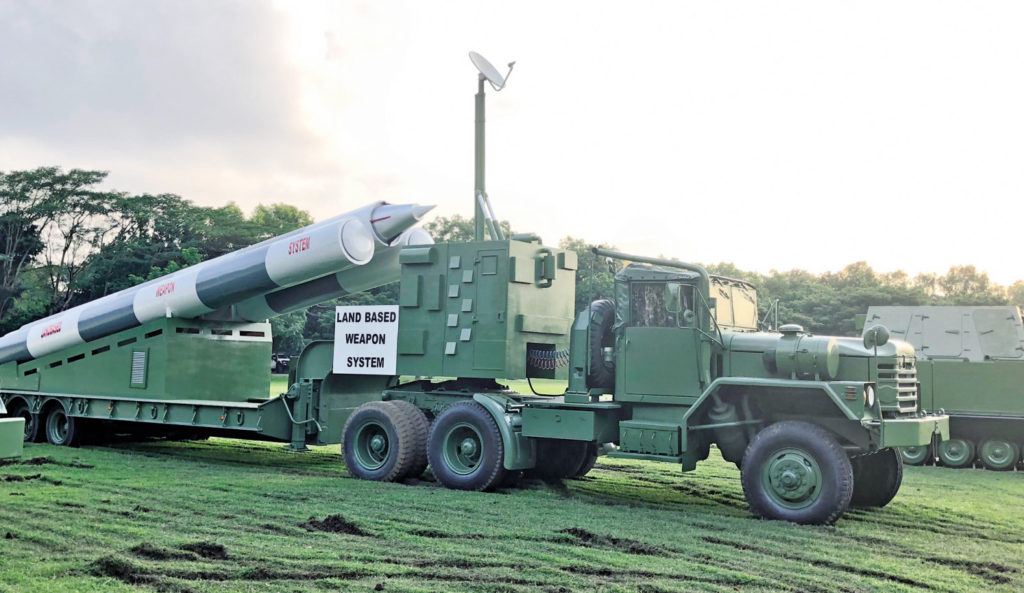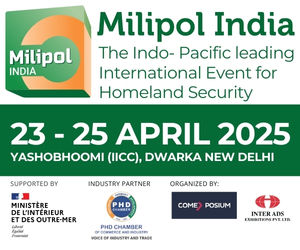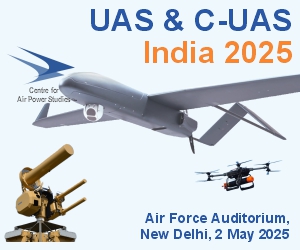
India recognizes ASEAN centrality (taken forward through ASEAN led institutions) in its Indo Pacific strategy. Relations between India and ASEAN have taken on a strategic dimension over time, going beyond political and economic engagement. India’s growing role in the Indo Pacific was acknowledged by the ASEAN countries during the 16th India- ASEAN Summit. The endorsement of India’s role assumes significance as it came in the midst of geo-political power play in the Indo-Pacific region and escalating territorial disputes between China and a number of ASEAN countries. This is significant in the wake of ASEAN outlook on the Indo Pacific.
In the security domain, India has been admitted into security led forums such as the ASEAN Regional Forum (ARF), the East Asian Summit( EAS) and the ASEAN Defence Minister’s Meeting(ADMM) Plus despite initial reluctance on the part of some ASEAN member states. Given that India has no history of territorial dispute or military conflict with Southeast Asia and it shares common norms for peace and security, India stands as an assuring power.
India’s defence relations with ASEAN can be looked at from both bilateral and multilateral perspective. India and ASEAN states have engaged in joint military exercises, organized operations, naval port calls, training and education, security dialogues, exchange of high-level visits, defence supplies, etc. in terms of bilateral defence ties.
Bilateral Perspective
For India, relations with South East Asian countries has a direct bearing on its Indo-Pacific strategy in which China is an important factor. Thus, India’s Act East Policy is welcomed in the region including the defence and security dimension as well. Relations with Thailand on the Bay of Bengal littoral and with Singapore, Indonesia and Malaysia straddling the Malacca Straits have strategic significance not only because of their position, but also because of their growing economies and their respective trade and commerce stature.
In addition, Malacca Strait is the key transit point through which more than 55% of India’s trade goes through. Another worrying factor for India is China’s growing naval presence in the Indian Ocean . On the high seas, there are risks and challenges of piracy and smuggling and other non-conventional threats that threaten the smooth flow of trade and commerce, thereby propelling countries to protect the sea lanes. Cooperation between India and these countries in defence and security has thus acquired increased salience over the years.
Myanmar. Myanmar shares long border with China in the north and is contiguous with the disputed Sino-Indian border. The geography makes it vulnerable to numerous strategic and security implications. Infiltration of the insurgents and arms trafficking in the Northeast is a priority for India. China’s strategic military ties with Myanmar makes it imperative for India to develop a robust defence and security cooperative framework with Myanmar. India has been pursuing enhanced defence relationship with Myanmar as a component of its erstwhile Look East and now Act East Policy.
A regular feature of bilateral security cooperation was the procurement of combat hardware, regular high-level military exchanges on both sides and joint training exercises. Since 2013, both countries’ navies have been carrying out organized patrols along the maritime boundary.
Thailand. In December 2011, the First India-Thailand Defence Dialogue took place in New Delhi, and in January 2012 a bilateral memorandum of understanding (MoU) on defence cooperation was signed. Regular joint exercises, coordinated maritime patrols near the international maritime border to counter terrorism, piracy and smuggling, training of officers at the training institutions of each other’s armed forces and participation as observers in military exercises fall within the scope of bilateral defence cooperation.
Thailand Navy was a regular participant in India led Milan series of joint naval exercises held biennially in Bay of Bengal. There is cooperation between the armies of both countries beyond the maritime domain.
The frequency and scale of bilateral exercises, however, needs to be increased and probably taken to the same level as what the Indian armed forces are doing with other South East Asian countries such as Singapore or Vietnam. There is substantial potential to broaden security cooperation with Thailand.
Singapore. In intensifying its engagement with ASEAN, Singapore has been a traditional supporter of India. India and Singapore have forged cooperation over the years in training forces, maritime safety, joint naval exercises, defence technology collaboration and military exchange programs. In addition, India provided access to armed forces in Singapore to use Indian training facilities such as air force and firing ranges for artillery. Naval drills are held annually between the two navies since 1994.
Indonesia. India’s Maritime Neighbour Indonesia in the ASEAN group is also India’s largest trading partner. Indonesia is India’s maritime neighbour with the closest distance between the two being about 90 nautical miles from India’s Great Nicobar Island. Both countries signed the Defence Cooperation Agreement in 2001. Since 2002, they have been carrying out regular joint India-Indonesia Coordinated Patrol along the maritime boundaries involving both navies ‘ ships and maritime aircraft. With the creation of a bilateral strategic partnership in 2005, the commitment to defence gained some momentum. Bilateral cooperation across the army, navy and air force has increased. At the Counter Insurgency and Jungle Warfare School (CIJWS) in Mizoram in 2012, joint army drills codenamed’ Garuda Shakti ‘ exercise took place.
There is daily formal communication between the Army and the Navies on both sides. Maritime cooperation between the two nations is an unstoppable part of the ongoing development of the strategic partnership. In December 2016, both sides emerged with a “Shared Vision of Indo-Pacific Indian-Indonesian Maritime Cooperation.”
Malaysia. Malaysia is India’s strategic partner and is strong on India’s Act East Policy. Since the signing of the MoU on Defence Cooperation (MIDCOM) in 1993, Indo-Malaysian defence and security cooperation is thus integral to the broader bilateral and regional engagement. The Army, Air Force and Naval Chiefs have regular high-level visits from both sides. The annual India-Malaysia Defence Cooperation Meeting was upgraded at the level of the Secretary of Defence during PM Modi’s visit to Malaysia in July 2018. Joint army exercise called’ Harimau Shakti’ has been carried out with the intention of exchanging the best practices and procedures of both armies in the conduct of counterinsurgency operations. Since 1997, the Malaysian Navy has been participating in the multilateral series of’ Milan’ joint naval exercises.
Vietnam. The security relationship between India and Vietnam was strong. Their mutual views of global and regional order in terms of strategy and security have helped shape commonalities. Over the years, India has improved its political-strategic relationship with Vietnam. This in turn helped the cooperation between defence and security to gain momentum.
A Strategic Partnership Agreement signed in 2007 further strengthened India-Vietnam’s officially signed defence and security partnership in 2000. This outlined how to further institutionalize and broaden the cooperation in defence and security. In addition to resolving the problems of non-conventional threats such as transnational crime and drug trafficking, the agreement established a mechanism for civil nuclear cooperation, counter-terrorism cooperation and strengthening regional security. Cooperation in defence and security remains an important aspect of the strategic partnership between the two countries. In May 2015, the two countries signed a Joint Vision Statement on Cooperation in Defence for the duration 2015-2020. The Indo-Vietnam relationship was upgraded to the Comprehensive Strategic Partnership in September 2016 to enhance cooperation in defence and security.

Philippines. There has been little progress in India’s security cooperation profile with the Philippines. The 2006 bilateral Defence Cooperation Agreement allows Naval and Coast Guard ships to share training, high-level visits, research tours and port calls. Their bilateral MOU on Defence Industry and Logistics Cooperation, signed in 2017, covered the purchase and export of defence articles and shared logistics support and services, as well as cooperation in defence material development, production and procurement.
It is quite apparent that there has not been much initiative in order to develop their bilateral defence ties. The second meeting of the Joint Committee for Defence Cooperation (JDCC) between the Philippines and India was held in 2017, five years after the first meeting of this kind in 2012.
Cambodia and Laos. The security relations between India and Cambodia and Laos are at an elementary level right now. Since 2007, India has been educating the Cambodian troops on demining as various conflicts and wars have left the countryside strewn with a large number of unmarked mining grounds.
Prime minister Modi stated in 2018 that India would strengthen relations in key areas of defence, intelligence, and counter-terrorism. Both sides expressed a desire to enhance cooperation in the maritime domain, including the preservation of the marine and coastal environment, anti-piracy cooperation and the security of sea lanes of communication in order to preserve peace and ensure navigation security in the Indo-Pacific region. But no specific steps have been listed to achieve these results.
Brunei. At the political level, Brunei endorsed India’s Act East Policy as well as India’s increasing relationship with ASEAN. Indian naval ships have visited Brunei on goodwill visits on a regular basis and also participated in the July 2011 Brunei International Fleet Review to mark the Royal Brunei Armed Forces ‘ 50th anniversary.
Brunei naval ships participated in the Milan series joint naval exercises in India. Furthermore, both sides also participated in the Defence Expos of each other. Military leaders and personnel have also visited both sides to improve the security relationship, both bilaterally and, multilaterally, at the meeting of ASEAN Defence Ministers Plus. In 2018, India and Brunei agreed to further strengthen defence relations by exchanging experiences, information, training, and trainers; holding joint military exercises, seminars, and discussions; and cooperating with defence industries.
It is quite clear that India needs to build on its relationship with Cambodia, Laos and Brunei in terms of defence and stability. India’s enhanced cooperation with these countries in politics and defence could have some effect on balancing the increasing Chinese presence in these countries.
Multilateral Perspective
India has also engaged the Southeast Asian states through multilateral initiatives such as Milan and the Indian Ocean Naval Symposium to project itself as a benevolent military power.
India is part of the framework of ADDM Plus that involves ten ASEAN countries and eight other nations. ADMM Plus, a central forum of ministers, fosters strategic dialogue and security cooperation between ASEAN and its eight partner countries, that is. China, Australia, New Zealand, Japan, South Korea, Russia, and the United States. ADMM Plus also includes “expert working groups” focused on seven different areas including counter-terrorism, maritime security, humanitarian and disaster relief and assistance for peacekeeping operations. Besides the Shangri-La dialogue, it is the only place that allows Southeast Asian defence chiefs to meet with counterparts from major powers such as the US and China.
ASEAN member countries took part in a series of joint naval exercises led by Milan in India. For the most part, the naval exercises aim to create a platform for the region’s littoral navies to share views on maritime cooperation and to conduct HADR drills and tackle non-traditional security challenges.
While in the initial years only a few countries such as India, Indonesia, Singapore and Thailand, all on the Bay of Bengal coast participated in the first edition of Milan exercises, many other countries’ navies joined for the manoeuvres over a period of time.
India has been participating regularly in joint naval exercises led by KOMODO in Indonesia since its beginning in 2014. The main focus of these exercises is on HADR.
India at ADMM Plus 2019
India’s participation in ADMM Plus reflects its goal of strengthening the relationship between defense and security with ASEAN countries. This year’s 6th ADMM Plus Summit was held in Bangkok on November 17. The central theme of the ADMM Plus Summit was “Advancing Sustainable Security Partnership,” which implies the importance of sustainability, harmony, stability, security, and navigation rights.
Defence minister Rajnath Singh outlined key aspects of India’s involvement in the ADMM Plus project. In the wake of the growing security challenges. He proposed the necessity to expand the matrix of defense preparedness that should encompass both traditional and non-traditional security threats. Referring to the severity of the security challenges raised by ‘terrorism’ and ‘radicalization’, Rajnath Singh reiterated India’s policy of zero tolerance of terrorism and called for collective action to counter the threat.
He indicated India’s stand against the growing assertiveness of China in its maritime neighborhood, but reaffirmed India’s commitment to rules-based order to address the issue of maritime security, recognizing international law as the leading anchor for dispute resolution. India also acknowledged its commitment to climate change, HADR. India stressed the importance of dialogue as an essential tool to strengthen regional security structure while at the same time maintaining ‘ASEAN Centrality.’
Conclusion
India’s security dynamics with ASEAN is conditioned by two primary factors:
• ASEAN outlook on the Indo Pacific that dilutes the narrative of India being projected as a balancer against China. While it recognizes the changing geopolitical realities, it emphasizes on exploring potential synergies with sub-regional frameworks.
• The rising urgency of addressing non-conventional threats in the maritime domain. In both the aspects, the elements of defence ties needs to be strengthened for maintaining their mutual commitment towards a free, open, prosperous and inclusive Indo-Pacific region.
Despite progress made in India-ASEAN ties over the past 25 years, the relationship still has tremendous scope for further development.

















